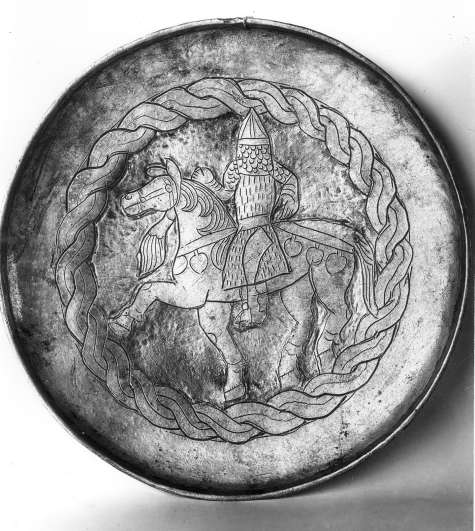Join Amazon Prime - Watch Thousands of Movies & TV Shows Anytime - Start Free Trial Now

Create an Amazon Wedding Registry
Magyar? horseman on a silver dish from Muzhy
9th - 10th centuries

A larger image of this Magyar? horseman on a silver dish from Muzhy
Source: Volga Bulgaria Silver of the 10th-14th centuries by Natalia V. Fedorova
Also as Dish with mounted warrior.
Central Europe/Hungary, ca. 10th c. Silver, gilding. Found Muzhi, Berezovskii u., Tobol'sk.
Published: Smirnov no. 156; Darkevich pl. 56/2, p. 173.
54. Bowl with a heavily armed rider.
Silver, gilding. Diameter 17.5.
Hungarians before moving to modern Hungary, IX century.
Found in Muzhi, now the Yamalo-Nenets National District. Stored in the State Hermitage, inv. No. S-207.
At the bottom of the bowl is a medallion surrounded by a braid of two double stripes.
At its edge there is a smooth field. Gilding and technique as in cat. No. 53, although the vessel is rougher.
Included in the early Hungarian group.
In terms of details: short strokes, scaly surfaces and surfaces cut by parallel lines,
the bowl can be attributed to the same craft tradition as the dish with a horse hunter found in the Kama region
(Smirnov, 1909, ill. 157; Darkevich, 1976, pl. 56, 4 ; Marschak, 1986, Abb. 123),
and according to the interpretation of the horse's hooves it is close to cat. No. 53, 55.
A rider is depicted on a horse with a harness decorated with leaf-shaped plaques, common among the Hungarians, and a plume suspended from the bridle
(a sign of the leader in Sogdian art).
On the rider's head is a helmet of riveted plates, with a chain mail aventail, his armour is probably made of plates connected by cords (lamellar), chain mail mantle.
The leg is inserted into the stirrup. The boot has a brace seam. On the hip hangs a bowcase, in which, however, there is no bow.
In general, there is no weapon of any kind, there is no horse's eye, and the rider is turned with the back of his head towards the viewer.
All this testifies, most likely, to the fear of the magical effects of images.
Probably this fear explains the extreme rarity of the figures of living beings in the later Hungarian art of the 10th century.
Source: Plate 54, "Treasures of the Ob Basin." Formika. 1996.228
Referenced as Figure 31B, Oriental Armour by H. Russell Robinson
A rock carving at Suljek in Siberia, probably representing an armed Avarian horseman, shows the conical helmet with Roman cheekguards and a long coat of lamellar armour with short sleeves.
The lamellae are represented by rows of short vertical lines, the same convention as that used on a silver dish in the Hermitage at Leningrad showing an eighth-century Turkish horseman (Fig. 31B).
Here the warrior is either turning his face away or is represented as wearing a veil of mail covering it.
The mail is shown by a scale-like convention frequently met with in art, particularly in Persian and later Mughal miniatures.
Like some Sāssānian warriors, this one wears a short sleeved mail shirt beneath his long coat of lamellar.
Two other interesting features are in evidence on this dish.
They are the large hair throat-plume attached to the throat-strap of the horse's bridle -
an ornament that was to be copied in eighteenth-century Europe with Polish and Hungarian uniforms,
both under strong Turkish influence and an early representation of the stirrup.
Referenced as figure 444 in The military technology of classical Islam by D Nicolle
444. Silver dish, 8th century AD, west Turkistānī, Hermitage, Leningrad (Rob QA).
See also an Asiatic Heavy Cavalrymen, an extract from Armies of the Dark Ages 600-1066 by Ian Heath
9th-10th century Magyar? horseman on a ewer from Nagyszentmiklós, 9th-10th century
Dish with mounted archer from Berezovskii u., Tobol'sk province, c.10th century
Dish with mounted falconer from Utemil'skii, c.10th century
Illustrations of Hungarian Costume & Soldiers


